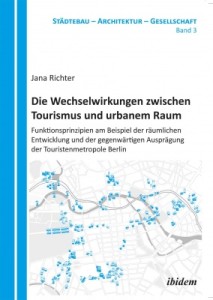Jana Richter: DIE WECHSELWIRKUNGEN ZWISCHEN TOURISMUS UND URBANEM RAUM Funktionsprinzipien am Beispiel der räumlichen Entwicklung und der gegenwärtigen Ausprägung der Touristenmetropole Berlin. ibedim Verlag. Berlin, 2012. ISBN: 978-3838203270
scroll down for English version
DIE WECHSELWIRKUNGEN ZWISCHEN TOURISMUS UND URBANEM RAUM
Funktionsprinzipien am Beispiel der räumlichen Entwicklung und der gegenwärtigen Ausprägung der Touristenmetropole Berlin
Tourismus verändert die gebaute Welt, in der wir leben. In besonderem Maße gilt dies für den Städtetourismus. Doch dieser Einfluss ist aus Sicht der Architektur und des Städtebaus bislang kaum ansatzweise erforscht. Für Architekten und Planer ist Tourismus zudem ein eher unbeliebtes Aufgabengebiet. Sie assoziieren Tourismus mit Disneyfizierung und Kommerzialisierung und beschränken sich gern auf den Bau von Landmarks, Hotelresorts und Besucherleitsystemen.
Die vorliegende Studie füllt die vorhandene Forschungslücke und etabliert so Tourismus als stadtplanerische Chance. Sie untersucht die Wechselwirkungen zwischen touristischen und urbanen Raumfunktionen. Am Beispiel Berlins wird nicht nur die steigende Bedeutung des Städtetourismus sichtbar, sondern auch dessen einseitige Wahrnehmung als Wirtschaftsfaktor.
THE INTERACTION OF TOURISM AND URBAN SPACE
“Functional Principles” between Tourism and Urban Space – the Spatial Development of Tourism in the Tourist City Berlin
This study fills the research gap and establishes tourism as a catalyst for urban planning. It analyzes the interactions between tourist and urban functions in the context of the tourist city Berlin. The point of departure is the classification of urban approaches in the spatial sciences, especially in the social and cultural science fields. The Berlin case not only shows the growing impact of urban tourism, but also its one-sided perception as an economic factor.
Additionally, a historic analysis displays the complex development of tourism and urban development. Rather than portray Berlin as an isolated case, it demonstrates the influence of global, technical, anthropogenic and cultural influences on urban tourism in Berlin. On the basis of four spatially based phenomena („visually designed spaces“, „instrumentality of information“, „consumption of goods and services“ and „permanent movement“) a broad theoretical matrix is developed. With this matrix the subset of tourism and urban development is made tangible. 26 principles of spatial functions are defined that aim for interregional universality with the help of practical analysis objects. In doing so, this publication contributes critical insights into how to harvest the long neglected potential of tourism for urban development.
